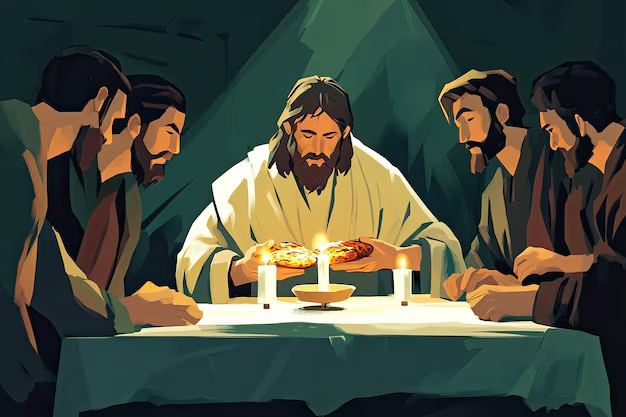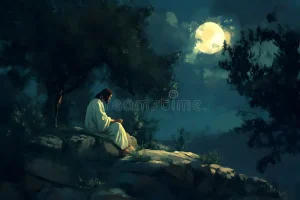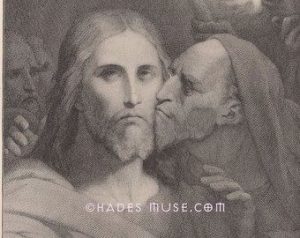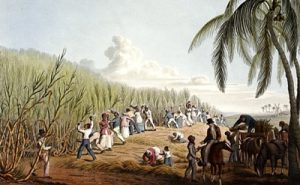There was a man named Jesus, and he was regarded by many as a healer, a teacher, and the long-awaited Messiah. The day became night, and all His disciples came across a building where they had rested after a long day, as He and His disciples sat and awaited for dinner, the night felt as if it was going to last forever. 1 Until the moment where Jesus broke the quietness with water being poured into a bowl, and a rag being grabbed by Him. The disciples must have felt confused and worried, because not only was there Messiah grabbing a bowl of water and a rag, but He knelt before his disciples feet and washed the feet of his disciples, showing how to love one another and to show humility to each other. 2 As this unfolded, we can imagine that His disciples felt a mixture of confusion, fear, and sadness, for this was the last night of Jesus’ earthly life, a proclamation that had been predestined before the foundation of the world, awaiting fulfillment by Him.3 We can imagine that Jesus felt a sense of dread and hesitancy during the meal He was about to share with His disciples, knowing that among the people He sat with, traveled with, and shared laughs with, one of them would soon betray Him that night for mere pieces of silver, and another disciple would deny that he even knew who He was, and yet he still showed them love, mercy and forgiveness towards them.4 Jesus, who had traveled out to Galilee to preach the gospel of the kingdom and perform miracles among the people of Galilee, by His Father’s decree. He showed the people of Galilee that this was the beginning of a new covenant of mercy that was to be redeemed through surrender, not conquest, by Jesus, who had been longing to do his Father’s will.5 Around the table in the shape of a U, Jesus began breaking bread with his disciples. As the cup was lifted by Jesus, symbolizing the deliverance of man, it took on a new meaning of the new covenant that was to be established through his body and blood. During the night, we can imagine that the shadows surrounding the building grew longer, foreshadowing the evil that was to come upon the Son of Man, from the hatred of Mankind.6 After Jesus and His disciples shared a meal together, they walked down the stone steps into the streets and toward the Garden of Gethsemane. Betrayal stirring in the air, courage wavering, sleep and fear closing in–but Jesus’ purpose held. Before dawn, the new covenant spoken to many by Jesus would become sealed in obedience to the Father’s will, and with calm resolve from Jesus, he would say, “Rise, let us go.”7
Beginning with Adam and Eve, sin caused a separation from God that couldn’t be mended. Much later, the people to whom God had promised lands and to whom He entrusted his plans and the future of the world were the Israelites. God, who had displayed mercy and blessings to the Israelites, brought them out of captivity, showed favor upon them, and loved them with all His might. He proclaimed the Israelites as “Mine.”8 However, since God had seen the actions of the people of Israel, and the blasphemy that they had done against Him and themselves, He turned his face from them and left them to their own demise.9 As sin continued to be a gap between God and Mankind, He wished to rekindle the bond He once had with his creation, to reignite the love we had for Him and He had for us. This wasn’t something that could have been done by those He created, but through the sacrifice of His son, a sinless man, who lived a perfect life. His name was Jesus.10 It was a new promise made by God through Jesus Christ, which established a new relationship between the Father and Humanity.11 From this, we can imagine that Jesus displayed a sense of love for people, not just for the Israelites, but for the entire world.12 Jesus didn’t show His love just from what He proclaimed to nations, but through the actions that He displayed toward the people of Galilee, and the kindness he showed to people who were seen as “Outcasts.”13

In Jesus’ final days, He spent his last days prophesying the word of His Father in heaven, all the way to the final supper He shared with His disciples, the friends with whom He traveled. He gathered them together for the last supper that He and they would have with each other, but before He sat down to dine, He requested a basin with water and a towel so He could wash the feet of His disciples. However, there was one among them who refused to let Jesus wash his feet. Why? Because he felt unworthy of someone like Him to even clean his feet, but Jesus said to him and to all his disciples, “Unless I wash you, you have no part with Me, we can have nothing to do with each other.”14 Jesus displayed a sense of humility, which in turn showed his disciples how we should treat one another, even with the people with whom we don’t see eye to eye. Jesus had washed Peter’s feet, a loyal friend who would publicly deny that he knew Jesus later that very night.15

During the Passover meal, Jesus sat down and broke bread with His disciples, saying, “This is my body, which you will eat.”16 This symbolized his body, which would be broken and given for the salvation of humanity. “Drink from it, all of you. This is my blood of the new covenant, which is poured out for many for the forgiveness of sins.“17 During the Passover meal, they continued in small talk among one another until Jesus interrupted them before they could eat. Suspense began to deepen once Jesus said to them, “Very truly, I tell you, one of you will betray me.”18 We can imagine that their tension turned into fear and self-doubt within themselves; they not only were anxious, but they couldn’t trust how they felt about their own emotions, fearing what the other might do to them, or even worse, to their rabbi.19 Through it all, Jesus still broke bread with the person who would soon betray him, and showed him love even though He knew what awaited him once He left that room. This act displayed a type of love that is unconditional and unwavering, showing us how to treat our enemies and how to love them as well, even through their faults.20

After His disciples finished their supper, and their conversations came to an end, they left the upper room. Some went out, but not all. Jesus took Peter, James, and John with Him to the Garden of Gethsemane because they were his inner circle of disciples.21 Through their walk with Jesus to Gethsemane, Jesus had reminded them again of what was to come and what He must do. Although we can imagine He did this not only to prepare them, but to display a sense of anxiety and sorrow about the physical and spiritual pain He was about to endure, displaying that He was also a human who had feelings and emotions just like any other person.22 we can imagine that that night felt heavy and dark, and stressful not only for His disciples, but for Jesus as well, knowing what was to come, and battling with His will and the will of His Father.

In the Garden of Gethsemane, Jesus told his disciples to pray and wait, for they needed to be watchful and spiritually prepared for the coming trials that were going to be approaching them and their teacher, Jesus, soon. He told them this because He knew that their human weakness would make it difficult to resist temptation, even though their hearts were willing.23 As Jesus slipped away from his disciples, He came across a rock and knelt before it with a prayer to his Father, whispering in the night wind. Alone, He felt the weight of a major decision pressing down on him; the quietness of the garden magnifying every heartbeat, the blood coming from every drop of sweat. This was a moment Jesus had to face without distraction, where Jesus had to decide to follow either His will or the will of His Father.
We can imagine that Jesus was scared, terrified even, terrified of what was to come to the point his sweat turned to blood. Terrified of what He was to endure from the people He loved and that loved Him. We can imagine He felt a sense of anxiety like you or I; He displayed a sense of human-like emotions just as any one of us. “Knowing what was ahead of him, it is understandable that Jesus would be overwhelmed by his emotions. Luke’s description of this dramatic scene invites us to engage in deeper reflection and consider times when we, too, have succumbed to our feelings.”24 In his prayer, a time came when He asked, “Father, if it is possible… let this cup pass from me.” 25 The words coming from his mouth were raw and honest, displaying the human side of Jesus. We can imagine He was in a state of fear and dread of what lay before him–nothing theatrical, nothing performative–showing us that even Jesus was just as human as anyone else, who has fears, fears of dying. He knows the path before Him, but He names his desires and his struggle with full clarity. As He continued to pray, the struggle arose, his flesh recoiling from pain, his mind haunted by what was to come. But each time He remembered what was to come, He chose obedience.26 Three cycles of prayer and return. His resolve was tested, sharpened, and reaffirmed through repetition, not ease.

A sense of calmness surrounded Jesus, as his breathing became more even, and His posture more fixed, as if He was ready for something coming his way. He turned to the sleeping men and gently shook them awake: “Rise, let us go.” 27 Through the olive trees and the stillness of the night, a familiar face appeared from the shadows, a disciple, a friend. Judas Iscariot, appearing before Jesus with guards who carried swords and wore heavy armor. Coming forward to Jesus and betraying him with a kiss on the cheek, displaying the initiation of the new covenant; no more bargaining, no more hesitation. The lanterns began to flicker through the olive tree shadows, as Jesus’ disciples fled in fear. The garden setting began to feel as if it were holding its breath, as the chains began to grow louder, and louder; He walked toward those flickering lights, waiting for the men who were to take him away, not as a victim, but as a man who was about to do what He was predestined to do.28
- “Matthew 26:20-25. ↵
- Planetshakers Team, “The Significance of Jesus Washing the Disciples’ Feet | Planetshakers,” Blog, Planet Shakers, March 31, 2023. ↵
- 1 Peter 1:20. ↵
- Sam Storms, “The Treachery of Judas Iscariot and the Sovereignty of God over Sin: John 13:1-32,” Church Plant Media, July 31, 2022 https://www.samstorms.org/all-articles/post/40–the-treachery-of-judas-iscariot-and-the-sovereignty-of-god-over-sin-john-131-32. ↵
- Barbara Robbins, “Jesus: His Example of Surrender,” HOPE & LIGHT, October 22, 2019 https://hopeandlight.blog/2019/10/22/jesus-his-example-of-surrender/. ↵
- Peter Wigton, Lift up Your Hearts: Breaking Bread Together, April 23, 2020. ↵
- Tom Riggle, “‘Rise, Let Us Go from Here,’” Medium, June 17, 2020. ↵
- 2 Chronicles 6:6. ↵
- 2 Chronicles 6:6. ↵
- Deacon Kostner, “God’s Desire for an Intimate Relationship with Humanity,” Parishable Items, October 25, 2020. ↵
- Herman Witsius, “Of the new covenant between God the Father and the Son,” Monergism, 2018. ↵
- 1 John 2:2 . ↵
- Robert Sang, “6 Outcasts in Luke’s Gospel That Jesus Welcomed Openly,” Drawing on the Word, August 9, 2018. ↵
- John 13:8. ↵
- Julia Batten, “What Is Foot Washing and What Does It Symbolize?,” He Gets Us. ↵
- Matthew 26:26. ↵
- Matthew 26:27-28. ↵
- John 13:21–30. ↵
- J.E. Talmage, “The Last Supper and the Betrayal. Jesus the Christ,” EdTech Books, 2023. ↵
- Caleb Jacobs, “Seeing Jesus’ Love for Judas Throughout the Betrayal,” Medium, August 1, 2022. ↵
- “Why Did Jesus Choose Peter, James, and John to Be His Inner Circle?,” January 4, 2022. ↵
- J.D, Pastor, What Really Happened in the Garden of Gethsemane – JD Greear Ministries, July 14, 2020. ↵
- Colin Smith, “Why Jesus Tells His Disciples to Watch and Pray,” Open the Bible, December 6, 2024. ↵
- Martin Pable, Lessons from Jesus’ Agony in the Garden | Franciscan Media, March 2018, February 24, 2018. ↵
- Matthew 26:39. ↵
- Susana Fleming, “Jesus and Anxiety – Stories – Rock Church.” ↵
- Tom Riggle, “‘Rise, Let Us Go from Here,’” Medium, June 17, 2020. ↵
- Thomas L. Leishman, “Betrayal, Arrest, and Trial,” The Christian Science Journal, January 1, 1974. ↵



